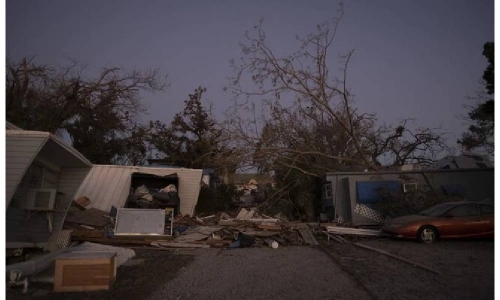Hurricane Ian death count rises to 83 in US
Agencies | Miami
The Daily Tribune – www.newsofbahrain.com
The death toll from Hurricane Ian climbed past 80 as embattled residents in Florida and the Carolinas faced a recovery expected to cost tens of billions of dollars, and some officials faced criticism over their response to the storm.
The death toll was expected to keep rising as floodwaters receded and search teams pushed farther into areas initially cut off from the outside world. Hundreds of people have been rescued as emergency workers sifted through homes and buildings inundated with water or completely washed away.
At least 85 storm-related deaths have been confirmed since Ian crashed ashore Florida's Gulf Coast with catastrophic force on Wednesday as a Category 4 hurricane with maximum sustained winds of 150 miles per hour (240 km per hour).
Florida accounted for all but four of the fatalities, with 42 tallied by the sheriff's office in coastal Lee County, which bore the brunt of the storm when it made landfall, and 39 other deaths reported by officials in four neighboring counties, according to Reuters.
Officials in Lee County, which includes Fort Myers and Cape Coral and is on the Gulf Coast, have faced questions over whether they mandated evacuations in time.
Cecil Pendergrass, chairman of the county's board of commissioners, said on Sunday that once the county was forecast to be in the cone, or the probable track of the hurricane's center, evacuation orders were given. Even then, some people chose to ride the storm out, Pendergrass said.
"I respect their choices," he said at a press conference. "But I'm sure a lot of them regret it now."
President Joe Biden and first lady Jill Biden will see the devastation in Florida firsthand on Wednesday, the White House said in a statement on Saturday. The Bidens will visit Puerto Rico on Monday, where hundreds of thousands of people were still without power two weeks after Hurricane Fiona hit the island.
Cuba is restoring power after Ian knocked out electricity to the whole country of 11 million people, flattened homes and obliterated agricultural fields.
North Carolina authorities said at least four people had been killed there. No deaths were immediately reported in South Carolina, where Ian made another U.S. landfall on Friday.
Chugging over land since then, Ian has diminished into an ever-weakening post-tropical cyclone.
The National Hurricane Center forecast more heavy rainfall was possible across parts of West Virginia and western Maryland into Sunday morning, and "major to record flooding" in central Florida.
As the full scope of devastation became clearer, officials said some of the heaviest damage was inflicted by wind-driven ocean surf that raged into seaside communities and washed buildings away.
Satellite images from the National Oceanic and Atmospheric Administration (NOAA) showed beach cottages and a motel that lined the shores of Florida's Sanibel Island had been demolished by storm surges. Although most homes appeared to still be standing, roof damage to all was evident.
Surveys from the ground showed that the barrier island, a popular tourist getaway that was home to some 6,000, was devastated.
"It's all just completely gone," Sanibel's city manager, Dana Souza, said. "Our electric system is pretty much destroyed, our sewer system has been damaged badly and our public water supply is under assessment."
The island's link to the mainland was severed by breaches to its causeway bridge, further complicating recovery efforts, Souza said.
After waning to a tropical storm by the end of its march across Florida to the Atlantic, Ian regained hurricane strength and pummeled coastal South Carolina on Friday, sweeping ashore near Georgetown, north of the historic port city of Charleston.
Numerous roads were flooded and blocked by fallen trees while a number of piers were damaged in that area.
More than 700,000 businesses and homes remained without power on Sunday afternoon in Florida alone, where more than 2 million customers lost electricity the first night of the storm.
Insurers braced for between $28 billion and $47 billion in claims from what could amount to the costliest Florida storm since Hurricane Andrew in 1992, according to U.S. property data and analytics company CoreLogic.
Related Posts

